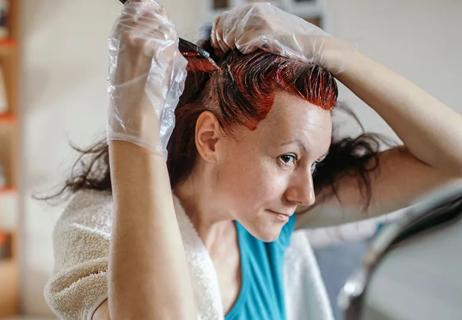This old-school hair removal method is painless if done correctly — but it’s not for everybody

Humans are creative. Especially when it comes to removing unwanted hair. Shaving. Waxing. Plucking. Sugaring. Threading. Crystal hair erasers. Lasers. We’ve done it all in the quest to find the most efficient, effective and painless fuzz-fighting technology.
Advertisement
Cleveland Clinic is a non-profit academic medical center. Advertising on our site helps support our mission. We do not endorse non-Cleveland Clinic products or services. Policy
Depilatory creams — one of the older approaches in the hair-removal pantheon — have been around for nearly a century now. We talked to aesthetician Lori Scarso about the risks and benefits of using them.
Depilatory creams use thioglycolic acid to break down the keratin protein in your hair. When you rinse the product off, the hair comes off with it.
Depilatory creams don’t remove the hair at the root like waxing and threading do. Instead, they make the hair structurally unstable; where exactly the hair breaks under the skin can vary. So, you can expect the hair to regrow faster than it does with waxing, but slower than it does with shaving.
Side note: Depilatory creams may be pain-free, but they aren’t always stink-free. One of the most commonly used ingredients in depilatory creams smells like rotten eggs, which … can be alarming the first time you experience it.
When it comes to removing unwanted hair, our needs and preferences vary. What matters most is what works best for you. That said, if you asked a depilatory cream devotee why they use these products, they’d probably say something along these lines:
Waxing, plucking, threading, sugaring — they all hurt a bit. Sure, shaving doesn’t hurt in theory, but it’s rare to get through all of your shaving sessions completely free of nicks and cuts.
Advertisement
But depending on your skin type, depilatory creams can be completely painless!
(There are definitely people who can’t comfortably use depilatory creams — we’ll come back to that in a bit.)
Another point in depilatory creams’ favor: They’re user-friendly. Just make sure you do a patch test first. From there, as long as you follow the directions on the box, bottle or tube to the letter, you should be good!
Scarso explains that, unlike most hair removal techniques, depilatory creams actually penetrate into the skin. As a result, they tend to be loaded up with moisturizers. It’s also often the case that the hair comes back slightly finer than it was to begin with.
If the idea of paying somebody to remove unwanted hair from your face or body doesn’t appeal, depilatory creams are a great option. You use them in the comfort and privacy of your own bathroom. And you don’t have to tip!
Depilatory creams are more affordable than some of the other hair-removal techniques out there.
Yes, the cost of buying these products adds up, but any option that removes hair below the surface will last longer than shaving. And depilatory creams are definitely a more affordable option than going to a salon or spa.
Prices vary from brand to brand, and depending on the type of hair the cream’s formulated to target. And it’s worth noting that while products marketed “for men” tend to be more expensive, the product is the same.
If you’re scared of using a razor — or manual dexterity is a concern — depilatory creams are a great at-home alternative to shaving.
Remember the active ingredient in depilatory creams: Thioglycolic acid. While generally safe, the potential side effects that come with using depilatory creams are more severe than most hair-removal techniques. Left on too long, these creams can cause first-, second- or even third-degree chemical burns. That’s why it’s extra important to do the following:
For example, don’t ever try to remove your facial hair — or, gasp, your pubic hair — with a depilatory cream designed for leg hair. There are different depilatory creams for different kinds of hair and skin. Putting it on the wrong body part is an easy way to end up with a chemical burn, so be sure to use the product as indicated.
“It’s very important to follow the manufacturer’s instructions regarding the length of time you keep the product on, which is usually between five and 10 minutes,” Scarso urges. Leaving the product on longer is likely to result in chemical burns.
Advertisement
It’s often the case that the depilatory cream doesn’t manage to loosen every hair because hair thickness is never completely uniform. That’s OK: You can always pluck or shave any strays that get left behind.
Now is not the time to conserve water. Make sure you wash depilatory creams off completely to avoid a chemical burn.
You’ve washed the product off. Now what?
“I would recommend using a moisturizer,” Scarso says. “Fragrance-free, nothing with perfumes … just a gentle, calming moisturizer to protect the skin.”
As you can probably imagine, rubbing thioglycolic acid on your body isn’t going to be a good idea for all people.
“If you have any kind of compromised skin, you always need to be careful with what you’re putting on it,” Scarso notes.
That includes people with sensitive skin or medical conditions like rosacea, eczema, psoriasis … even sunburn or acne. It also includes people using skin products (like retinols or retinoids) that make their skin more sensitive.
Even if you don’t have skin conditions, you may experience redness or irritation using a depilatory cream. That’s why you should always do a patch test first.
It’s also important to read up on the ingredients in any product you’re considering using, to ensure you aren’t allergic to any of the components.
Advertisement
Depilatory creams, used exactly as specified by the manufacturer, can be a wonderful DIY hair-removal option. They’re quick, affordable, painless and don’t require a trip to a spa or salon. But depilatory creams aren’t for everybody. And their side effects can be severe. People with sensitive or damaged skin should avoid these products, as should people with chronic skin conditions.
If you decide depilatory creams are a good option for you, it’s crucial to use the correct cream for the kind of hair you’re removing, conduct a patch test and rinse the cream off thoroughly within the time period specified on the packaging.
How and if you remove unwanted hair is a question of preference. The only way to know if depilatory cream’s your dream technique: Try it!
Advertisement
Learn more about our editorial process.
Advertisement

Focus on nutrition, gentle styling habits and adapting to your hair type

Eating whole grains, salmon, fruits and vegetables can help you achieve longer, healthier locks

Your genes, ethnicity, diet and stress levels may all affect your facial hair

Prepping the area, exfoliating beforehand and communicating with your esthetician will help give you the best (and least painful) results

Pumpkin seed oil supplements may help with hair loss, but they may not be right for everyone

While there’s little risk in trying this hair care treatment, there isn’t much science to back up the claims

Research shows some associations and concerns, but no definitive connections

Study results don’t conclude hair straighteners cause cancer, but they do raise questions

If you’re feeling short of breath, sleep can be tough — propping yourself up or sleeping on your side may help

If you fear the unknown or find yourself needing reassurance often, you may identify with this attachment style

If you’re looking to boost your gut health, it’s better to get fiber from whole foods